Taxation Law: Income Tax Calculation & Application - Assignment
VerifiedAdded on 2023/06/04
|6
|1323
|415
Homework Assignment
AI Summary
This assignment solution focuses on Taxation Law, specifically income tax calculation and application in the Australian context. It addresses various scenarios involving resident and non-resident individuals, companies, and working holiday visa holders, applying the 2017-2018 tax brackets and the corporate tax rate of 27.5%. The solution calculates tax payable for different income levels, considering medical levy and surcharge thresholds. It also provides detailed calculations for dividend tax owed, including imputation tax credits. The assignment includes practical examples and references to relevant Australian taxation laws and accounting standards.
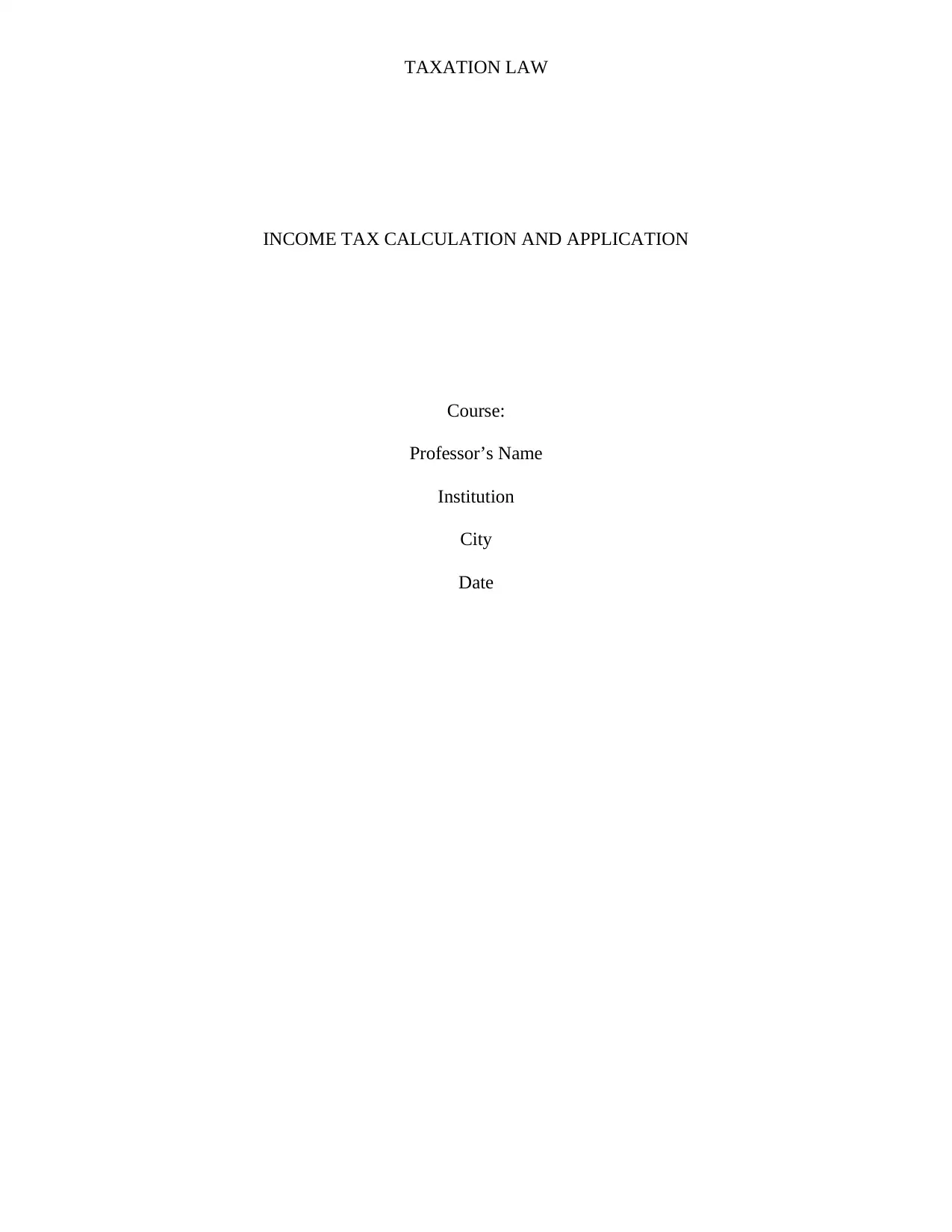
TAXATION LAW
INCOME TAX CALCULATION AND APPLICATION
Course:
Professor’s Name
Institution
City
Date
INCOME TAX CALCULATION AND APPLICATION
Course:
Professor’s Name
Institution
City
Date
Paraphrase This Document
Need a fresh take? Get an instant paraphrase of this document with our AI Paraphraser

TAXATION LAW
Question 1;
The 2017-2018 tax brackets are used in calculation of tax payable for resident and non-resident
individual together with the corporate tax rate of 27.5% for companies as referenced by
(Woellner, Barkoczy, Murphy, Evans and Pinto, 2010.Pg.7.)This usage of 2017-2018 tax bracket
and not that of 2018-2019 is because the income in analysis is for 30th June 2018 hence
explaining that since the Australian year end in June hence the usage of 30th June.
(a) 15000 dollar earned by the Australian resident lies in bracket (0 – $18,200 Nil) hence no
tax payable on this income thus the ‘’NIL’’ tax on the income (Hopkins, 2011.Pg.23.)
(b)An Australian company earning 15000 dollars is subjected to 27.5% corporate tax thus tax
payable=15000*27.5%=$4125
(c)An individual earning 155000 qualifies in bracket $87,001 – $180,000 $19,822 plus 37c for
each $1 over $87, 000, thus the over is=155000-87000=68000 hence the 37cents of
68000=68000*37/100=$25,160 therefore tax pay=25160+19822=44982 dollars
(d)An income of 155000 earned by a company is to subjected to 27.5%, hence tax
payable=27.5%*155000=$42625
(e)An individual taxable income of 255000 falls in bracket $180,001 and over $54,232 plus
45c for each $1 over $180,000 hence the over 180000 is=255000-
180000=75000*45/100=$33,750, therefore tax pay=33750+54232=87,982 dollars
(f)A non-resident income of 255000 falls in foreign resident bracket $180,001 and over $62,685
plus 45c for each $1 over $180,000, the over 180000=255000-180000=75000*0.45=33750
Total Tax Payable=33750+62685=$96435
(g)A working holiday visa individual is classified as foreign individual resident for tax purpose
hence the 255000 is subjected in tax bracket $180,001 and over $62,685 plus 45c for each $1
Question 1;
The 2017-2018 tax brackets are used in calculation of tax payable for resident and non-resident
individual together with the corporate tax rate of 27.5% for companies as referenced by
(Woellner, Barkoczy, Murphy, Evans and Pinto, 2010.Pg.7.)This usage of 2017-2018 tax bracket
and not that of 2018-2019 is because the income in analysis is for 30th June 2018 hence
explaining that since the Australian year end in June hence the usage of 30th June.
(a) 15000 dollar earned by the Australian resident lies in bracket (0 – $18,200 Nil) hence no
tax payable on this income thus the ‘’NIL’’ tax on the income (Hopkins, 2011.Pg.23.)
(b)An Australian company earning 15000 dollars is subjected to 27.5% corporate tax thus tax
payable=15000*27.5%=$4125
(c)An individual earning 155000 qualifies in bracket $87,001 – $180,000 $19,822 plus 37c for
each $1 over $87, 000, thus the over is=155000-87000=68000 hence the 37cents of
68000=68000*37/100=$25,160 therefore tax pay=25160+19822=44982 dollars
(d)An income of 155000 earned by a company is to subjected to 27.5%, hence tax
payable=27.5%*155000=$42625
(e)An individual taxable income of 255000 falls in bracket $180,001 and over $54,232 plus
45c for each $1 over $180,000 hence the over 180000 is=255000-
180000=75000*45/100=$33,750, therefore tax pay=33750+54232=87,982 dollars
(f)A non-resident income of 255000 falls in foreign resident bracket $180,001 and over $62,685
plus 45c for each $1 over $180,000, the over 180000=255000-180000=75000*0.45=33750
Total Tax Payable=33750+62685=$96435
(g)A working holiday visa individual is classified as foreign individual resident for tax purpose
hence the 255000 is subjected in tax bracket $180,001 and over $62,685 plus 45c for each $1
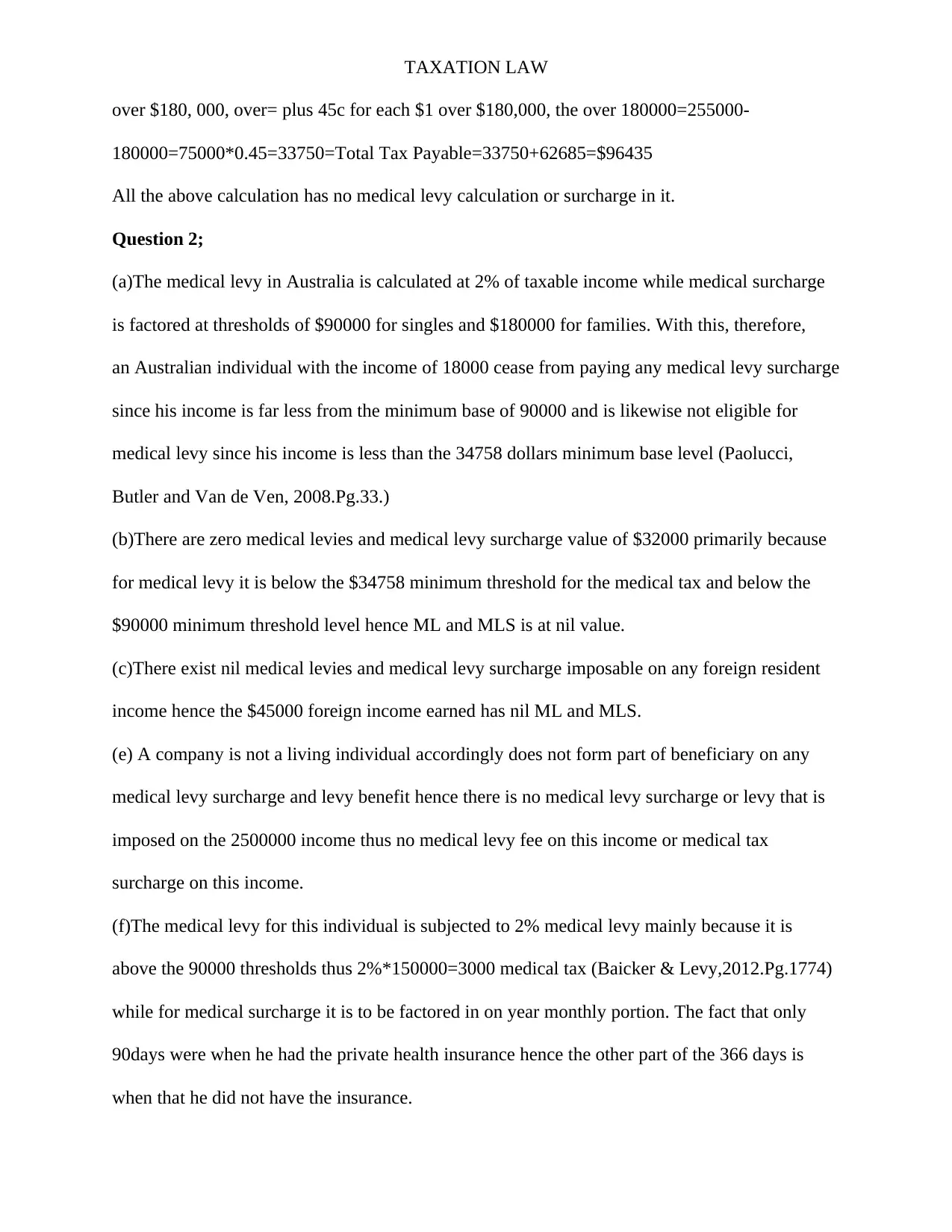
TAXATION LAW
over $180, 000, over= plus 45c for each $1 over $180,000, the over 180000=255000-
180000=75000*0.45=33750=Total Tax Payable=33750+62685=$96435
All the above calculation has no medical levy calculation or surcharge in it.
Question 2;
(a)The medical levy in Australia is calculated at 2% of taxable income while medical surcharge
is factored at thresholds of $90000 for singles and $180000 for families. With this, therefore,
an Australian individual with the income of 18000 cease from paying any medical levy surcharge
since his income is far less from the minimum base of 90000 and is likewise not eligible for
medical levy since his income is less than the 34758 dollars minimum base level (Paolucci,
Butler and Van de Ven, 2008.Pg.33.)
(b)There are zero medical levies and medical levy surcharge value of $32000 primarily because
for medical levy it is below the $34758 minimum threshold for the medical tax and below the
$90000 minimum threshold level hence ML and MLS is at nil value.
(c)There exist nil medical levies and medical levy surcharge imposable on any foreign resident
income hence the $45000 foreign income earned has nil ML and MLS.
(e) A company is not a living individual accordingly does not form part of beneficiary on any
medical levy surcharge and levy benefit hence there is no medical levy surcharge or levy that is
imposed on the 2500000 income thus no medical levy fee on this income or medical tax
surcharge on this income.
(f)The medical levy for this individual is subjected to 2% medical levy mainly because it is
above the 90000 thresholds thus 2%*150000=3000 medical tax (Baicker & Levy,2012.Pg.1774)
while for medical surcharge it is to be factored in on year monthly portion. The fact that only
90days were when he had the private health insurance hence the other part of the 366 days is
when that he did not have the insurance.
over $180, 000, over= plus 45c for each $1 over $180,000, the over 180000=255000-
180000=75000*0.45=33750=Total Tax Payable=33750+62685=$96435
All the above calculation has no medical levy calculation or surcharge in it.
Question 2;
(a)The medical levy in Australia is calculated at 2% of taxable income while medical surcharge
is factored at thresholds of $90000 for singles and $180000 for families. With this, therefore,
an Australian individual with the income of 18000 cease from paying any medical levy surcharge
since his income is far less from the minimum base of 90000 and is likewise not eligible for
medical levy since his income is less than the 34758 dollars minimum base level (Paolucci,
Butler and Van de Ven, 2008.Pg.33.)
(b)There are zero medical levies and medical levy surcharge value of $32000 primarily because
for medical levy it is below the $34758 minimum threshold for the medical tax and below the
$90000 minimum threshold level hence ML and MLS is at nil value.
(c)There exist nil medical levies and medical levy surcharge imposable on any foreign resident
income hence the $45000 foreign income earned has nil ML and MLS.
(e) A company is not a living individual accordingly does not form part of beneficiary on any
medical levy surcharge and levy benefit hence there is no medical levy surcharge or levy that is
imposed on the 2500000 income thus no medical levy fee on this income or medical tax
surcharge on this income.
(f)The medical levy for this individual is subjected to 2% medical levy mainly because it is
above the 90000 thresholds thus 2%*150000=3000 medical tax (Baicker & Levy,2012.Pg.1774)
while for medical surcharge it is to be factored in on year monthly portion. The fact that only
90days were when he had the private health insurance hence the other part of the 366 days is
when that he did not have the insurance.
⊘ This is a preview!⊘
Do you want full access?
Subscribe today to unlock all pages.

Trusted by 1+ million students worldwide
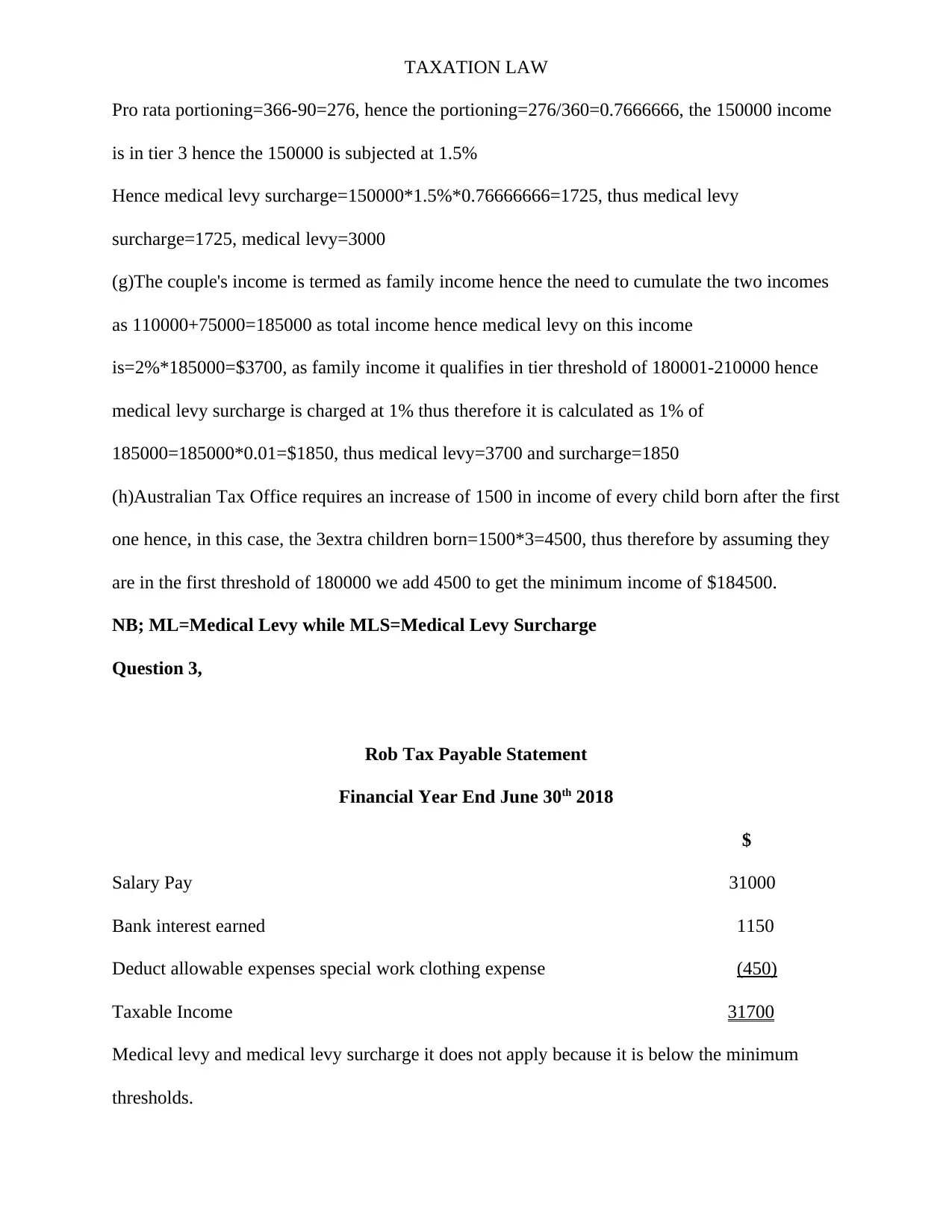
TAXATION LAW
Pro rata portioning=366-90=276, hence the portioning=276/360=0.7666666, the 150000 income
is in tier 3 hence the 150000 is subjected at 1.5%
Hence medical levy surcharge=150000*1.5%*0.76666666=1725, thus medical levy
surcharge=1725, medical levy=3000
(g)The couple's income is termed as family income hence the need to cumulate the two incomes
as 110000+75000=185000 as total income hence medical levy on this income
is=2%*185000=$3700, as family income it qualifies in tier threshold of 180001-210000 hence
medical levy surcharge is charged at 1% thus therefore it is calculated as 1% of
185000=185000*0.01=$1850, thus medical levy=3700 and surcharge=1850
(h)Australian Tax Office requires an increase of 1500 in income of every child born after the first
one hence, in this case, the 3extra children born=1500*3=4500, thus therefore by assuming they
are in the first threshold of 180000 we add 4500 to get the minimum income of $184500.
NB; ML=Medical Levy while MLS=Medical Levy Surcharge
Question 3,
Rob Tax Payable Statement
Financial Year End June 30th 2018
$
Salary Pay 31000
Bank interest earned 1150
Deduct allowable expenses special work clothing expense (450)
Taxable Income 31700
Medical levy and medical levy surcharge it does not apply because it is below the minimum
thresholds.
Pro rata portioning=366-90=276, hence the portioning=276/360=0.7666666, the 150000 income
is in tier 3 hence the 150000 is subjected at 1.5%
Hence medical levy surcharge=150000*1.5%*0.76666666=1725, thus medical levy
surcharge=1725, medical levy=3000
(g)The couple's income is termed as family income hence the need to cumulate the two incomes
as 110000+75000=185000 as total income hence medical levy on this income
is=2%*185000=$3700, as family income it qualifies in tier threshold of 180001-210000 hence
medical levy surcharge is charged at 1% thus therefore it is calculated as 1% of
185000=185000*0.01=$1850, thus medical levy=3700 and surcharge=1850
(h)Australian Tax Office requires an increase of 1500 in income of every child born after the first
one hence, in this case, the 3extra children born=1500*3=4500, thus therefore by assuming they
are in the first threshold of 180000 we add 4500 to get the minimum income of $184500.
NB; ML=Medical Levy while MLS=Medical Levy Surcharge
Question 3,
Rob Tax Payable Statement
Financial Year End June 30th 2018
$
Salary Pay 31000
Bank interest earned 1150
Deduct allowable expenses special work clothing expense (450)
Taxable Income 31700
Medical levy and medical levy surcharge it does not apply because it is below the minimum
thresholds.
Paraphrase This Document
Need a fresh take? Get an instant paraphrase of this document with our AI Paraphraser
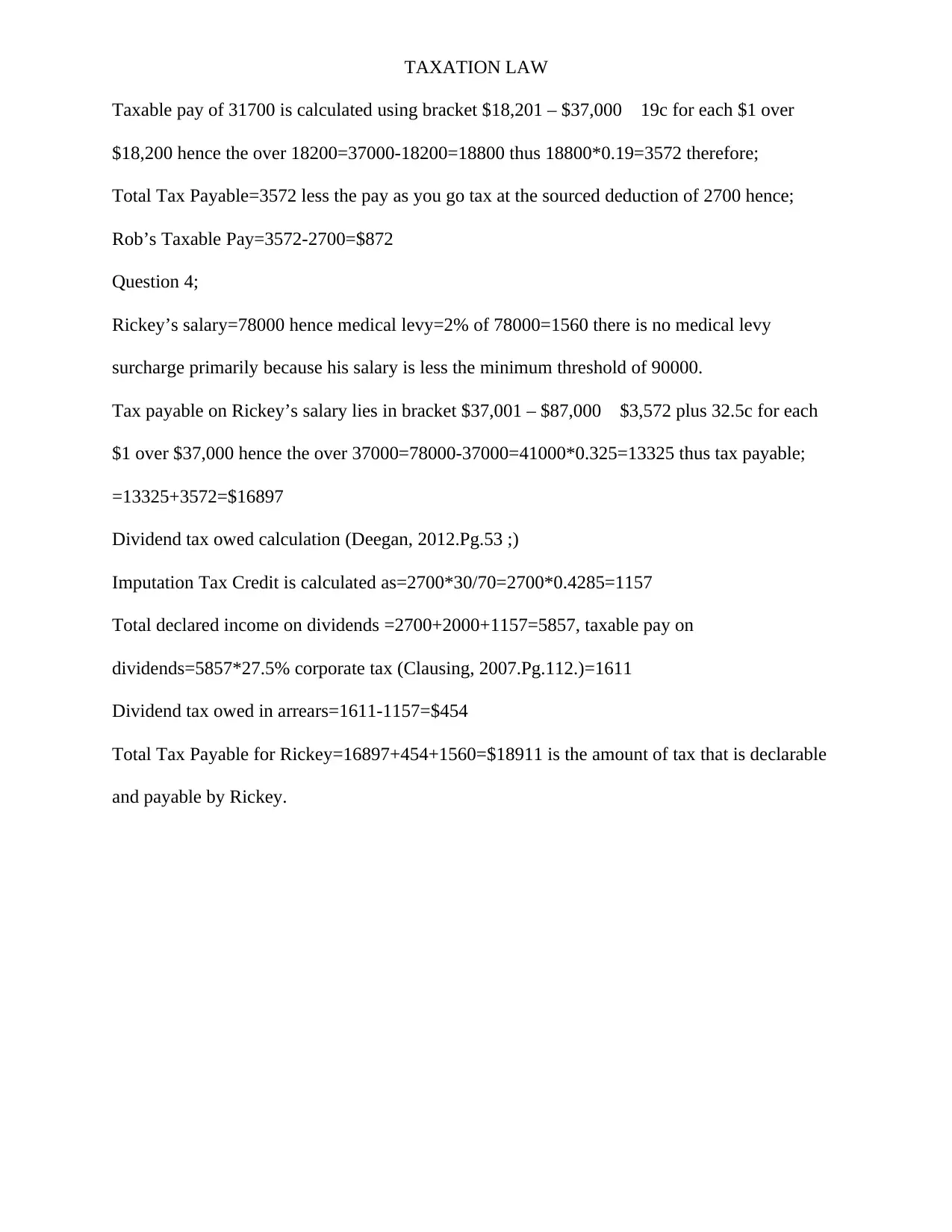
TAXATION LAW
Taxable pay of 31700 is calculated using bracket $18,201 – $37,000 19c for each $1 over
$18,200 hence the over 18200=37000-18200=18800 thus 18800*0.19=3572 therefore;
Total Tax Payable=3572 less the pay as you go tax at the sourced deduction of 2700 hence;
Rob’s Taxable Pay=3572-2700=$872
Question 4;
Rickey’s salary=78000 hence medical levy=2% of 78000=1560 there is no medical levy
surcharge primarily because his salary is less the minimum threshold of 90000.
Tax payable on Rickey’s salary lies in bracket $37,001 – $87,000 $3,572 plus 32.5c for each
$1 over $37,000 hence the over 37000=78000-37000=41000*0.325=13325 thus tax payable;
=13325+3572=$16897
Dividend tax owed calculation (Deegan, 2012.Pg.53 ;)
Imputation Tax Credit is calculated as=2700*30/70=2700*0.4285=1157
Total declared income on dividends =2700+2000+1157=5857, taxable pay on
dividends=5857*27.5% corporate tax (Clausing, 2007.Pg.112.)=1611
Dividend tax owed in arrears=1611-1157=$454
Total Tax Payable for Rickey=16897+454+1560=$18911 is the amount of tax that is declarable
and payable by Rickey.
Taxable pay of 31700 is calculated using bracket $18,201 – $37,000 19c for each $1 over
$18,200 hence the over 18200=37000-18200=18800 thus 18800*0.19=3572 therefore;
Total Tax Payable=3572 less the pay as you go tax at the sourced deduction of 2700 hence;
Rob’s Taxable Pay=3572-2700=$872
Question 4;
Rickey’s salary=78000 hence medical levy=2% of 78000=1560 there is no medical levy
surcharge primarily because his salary is less the minimum threshold of 90000.
Tax payable on Rickey’s salary lies in bracket $37,001 – $87,000 $3,572 plus 32.5c for each
$1 over $37,000 hence the over 37000=78000-37000=41000*0.325=13325 thus tax payable;
=13325+3572=$16897
Dividend tax owed calculation (Deegan, 2012.Pg.53 ;)
Imputation Tax Credit is calculated as=2700*30/70=2700*0.4285=1157
Total declared income on dividends =2700+2000+1157=5857, taxable pay on
dividends=5857*27.5% corporate tax (Clausing, 2007.Pg.112.)=1611
Dividend tax owed in arrears=1611-1157=$454
Total Tax Payable for Rickey=16897+454+1560=$18911 is the amount of tax that is declarable
and payable by Rickey.
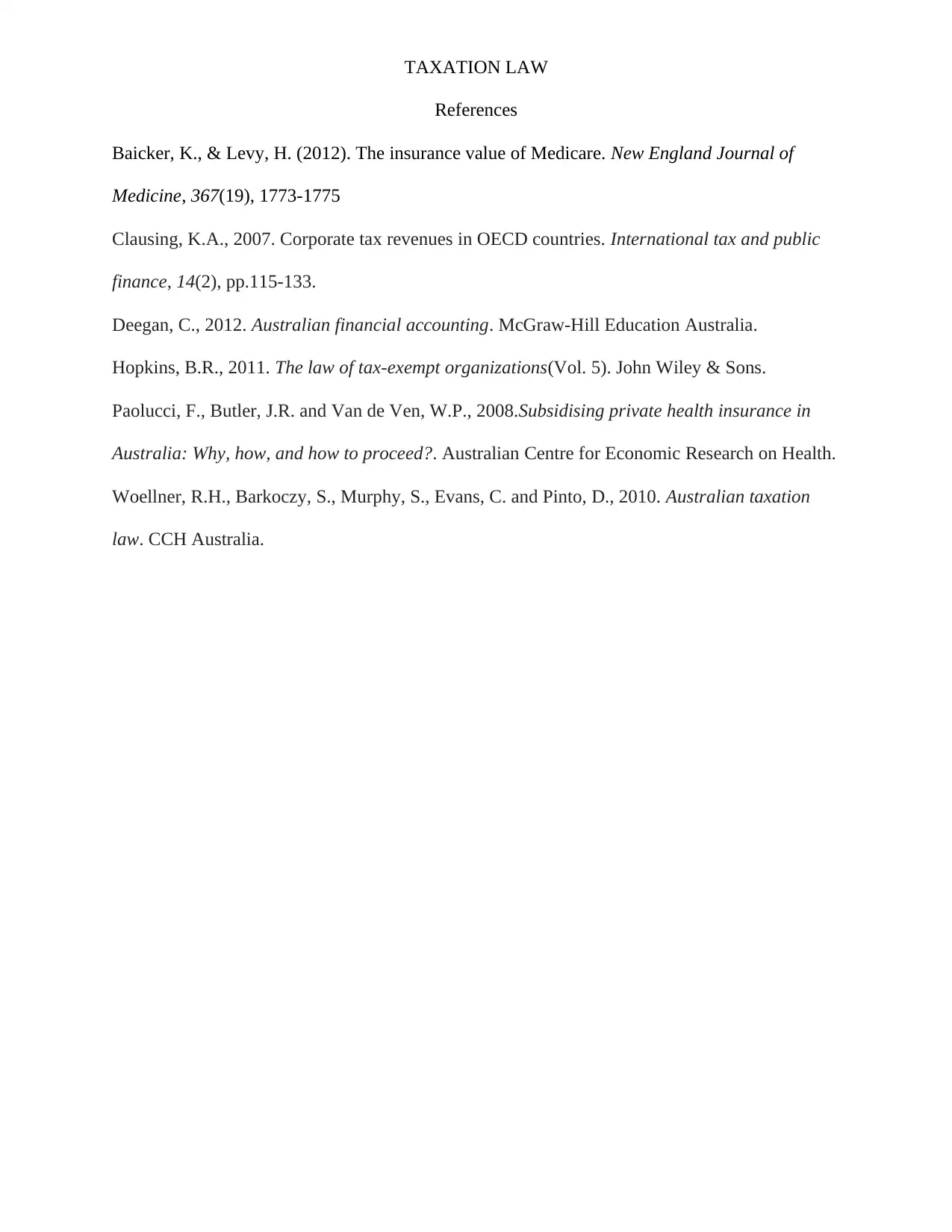
TAXATION LAW
References
Baicker, K., & Levy, H. (2012). The insurance value of Medicare. New England Journal of
Medicine, 367(19), 1773-1775
Clausing, K.A., 2007. Corporate tax revenues in OECD countries. International tax and public
finance, 14(2), pp.115-133.
Deegan, C., 2012. Australian financial accounting. McGraw-Hill Education Australia.
Hopkins, B.R., 2011. The law of tax-exempt organizations(Vol. 5). John Wiley & Sons.
Paolucci, F., Butler, J.R. and Van de Ven, W.P., 2008.Subsidising private health insurance in
Australia: Why, how, and how to proceed?. Australian Centre for Economic Research on Health.
Woellner, R.H., Barkoczy, S., Murphy, S., Evans, C. and Pinto, D., 2010. Australian taxation
law. CCH Australia.
References
Baicker, K., & Levy, H. (2012). The insurance value of Medicare. New England Journal of
Medicine, 367(19), 1773-1775
Clausing, K.A., 2007. Corporate tax revenues in OECD countries. International tax and public
finance, 14(2), pp.115-133.
Deegan, C., 2012. Australian financial accounting. McGraw-Hill Education Australia.
Hopkins, B.R., 2011. The law of tax-exempt organizations(Vol. 5). John Wiley & Sons.
Paolucci, F., Butler, J.R. and Van de Ven, W.P., 2008.Subsidising private health insurance in
Australia: Why, how, and how to proceed?. Australian Centre for Economic Research on Health.
Woellner, R.H., Barkoczy, S., Murphy, S., Evans, C. and Pinto, D., 2010. Australian taxation
law. CCH Australia.
⊘ This is a preview!⊘
Do you want full access?
Subscribe today to unlock all pages.

Trusted by 1+ million students worldwide
1 out of 6
Related Documents
Your All-in-One AI-Powered Toolkit for Academic Success.
+13062052269
info@desklib.com
Available 24*7 on WhatsApp / Email
![[object Object]](/_next/static/media/star-bottom.7253800d.svg)
Unlock your academic potential
Copyright © 2020–2025 A2Z Services. All Rights Reserved. Developed and managed by ZUCOL.





